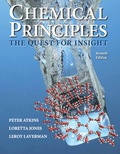
Concept explainers
(a)
Interpretation:
The wavelength of the ejected electron having wavelength of
Concept Introduction:
de Broglie relation:
Mathematically, de Broglie relation can be represented as given below.
Where,
(a)
Answer to Problem 1B.15E
The wavelength of the ejected electron having wavelength of
Explanation of Solution
Given that, the velocity of electron is
The de Broglie relation is given below.
By plugging all data in the above equation, the value of wavelength of the electron can be calculated.
Therefore, the wavelength of the ejected electron having wavelength of
(b)
Interpretation:
The energy required to remove the electron from the metal has to be calculated.
Concept Introduction:
Energy of a photon can be expressed mathematically as given below.
Where, h is the Planck’s constant,
(b)
Answer to Problem 1B.15E
The energy required to remove the electron from the metal is
Explanation of Solution
Given that, the frequency of the radiation is
Therefore, the energy required to remove the electron from the metal is
(c)
Interpretation:
The wavelength of the radiation that caused photoejection of electron with a velocity of
Concept Introduction:
If the energy of the photon is greater than work function, then an electron can be ejected with a kinetic energy,
Where,
(c)
Answer to Problem 1B.15E
The wavelength of the radiation that caused photoejection of electron is
Explanation of Solution
Given that, the speed of an electron that is emitted from the surface of a sample of chromium metal by a photon is
The expression of kinetic energy is given below.
Where,
By plugging all data in the above equation, the value of kinetic energy can be calculated.
The energy of incoming photon can be calculated as given below.
By plugging all data in the above equation, the energy of incoming photon can be calculated.
Therefore, the wavelength of the radiation that caused photoejection of electron is
(d)
Interpretation:
The kind of
Concept Introduction:
The wavelengths of electromagnetic radiation and their corresponding frequencies are given below in the table.
| Radiation type | Frequency / | Wavelength / | Energy of photon / |
| x-rays and | |||
| Ultraviolet | |||
| Visible light | |||
| Violet | |||
| Blue | |||
| Green | |||
| Yellow | |||
| Orange | |||
| Red | |||
| Infrared | |||
| Microwaves and radio waves | |||
(d)
Explanation of Solution
The wavelength of the radiation that caused photoejection of electron is
Therefore, the kind of electromagnetic radiation used is X- rays.
Want to see more full solutions like this?
Chapter 1 Solutions
EBK CHEMICAL PRINCIPLES
- When the Sojourner spacecraft landed on Mars in 1997, the planet was approximately 7.8 107 km from Earth. How long did it take for the television picture signal to reach Earth from Mars?arrow_forwardDoes the main emission line for SrCl2 have a longer or shorter wavelength than that of the yellow line from NaCI?arrow_forwardThis laser emits green light with a wavelength of 533 nm. (a) What is the energy, in joules, of one photon of light at this wavelength? (b) If a particular laser produces 1.00 watt (W) of power (1 W = 1 J/s), how many photons are produced each second by the laser?arrow_forward
- The root-mean-square speed of an oxygen molecule, O2, at 21C is 479 m/s. Calculate the de Broglie wavelength for an O2 molecule traveling at this speed. How does this wavelength compare with the approximate length of this molecule, which is about 242 pm? (For this comparison, state the wavelength as a percentage of the molecular length.)arrow_forwardA photoemissive material has a threshold energy, Emin = 5 1019 J. Will 300. nm radiation eject electrons from the material? Explain.arrow_forward
 Chemistry: The Molecular ScienceChemistryISBN:9781285199047Author:John W. Moore, Conrad L. StanitskiPublisher:Cengage Learning
Chemistry: The Molecular ScienceChemistryISBN:9781285199047Author:John W. Moore, Conrad L. StanitskiPublisher:Cengage Learning Chemistry: Principles and PracticeChemistryISBN:9780534420123Author:Daniel L. Reger, Scott R. Goode, David W. Ball, Edward MercerPublisher:Cengage Learning
Chemistry: Principles and PracticeChemistryISBN:9780534420123Author:Daniel L. Reger, Scott R. Goode, David W. Ball, Edward MercerPublisher:Cengage Learning Principles of Modern ChemistryChemistryISBN:9781305079113Author:David W. Oxtoby, H. Pat Gillis, Laurie J. ButlerPublisher:Cengage Learning
Principles of Modern ChemistryChemistryISBN:9781305079113Author:David W. Oxtoby, H. Pat Gillis, Laurie J. ButlerPublisher:Cengage Learning General Chemistry - Standalone book (MindTap Cour...ChemistryISBN:9781305580343Author:Steven D. Gammon, Ebbing, Darrell Ebbing, Steven D., Darrell; Gammon, Darrell Ebbing; Steven D. Gammon, Darrell D.; Gammon, Ebbing; Steven D. Gammon; DarrellPublisher:Cengage Learning
General Chemistry - Standalone book (MindTap Cour...ChemistryISBN:9781305580343Author:Steven D. Gammon, Ebbing, Darrell Ebbing, Steven D., Darrell; Gammon, Darrell Ebbing; Steven D. Gammon, Darrell D.; Gammon, Ebbing; Steven D. Gammon; DarrellPublisher:Cengage Learning Chemistry for Engineering StudentsChemistryISBN:9781337398909Author:Lawrence S. Brown, Tom HolmePublisher:Cengage Learning
Chemistry for Engineering StudentsChemistryISBN:9781337398909Author:Lawrence S. Brown, Tom HolmePublisher:Cengage Learning Chemistry & Chemical ReactivityChemistryISBN:9781337399074Author:John C. Kotz, Paul M. Treichel, John Townsend, David TreichelPublisher:Cengage Learning
Chemistry & Chemical ReactivityChemistryISBN:9781337399074Author:John C. Kotz, Paul M. Treichel, John Townsend, David TreichelPublisher:Cengage Learning





